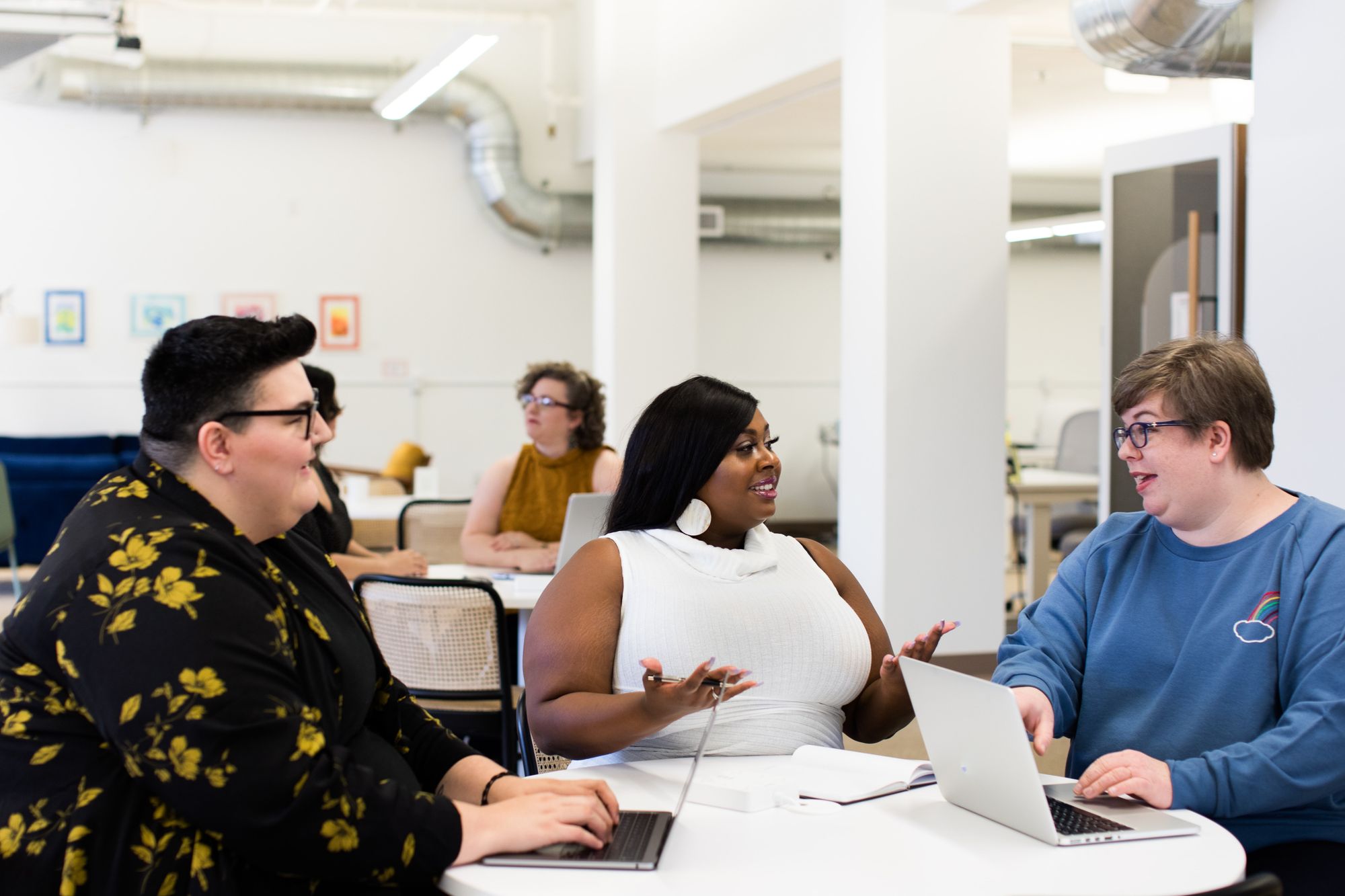With diversity and inclusivity at the forefront of many businesses' minds, unconscious bias is quickly becoming a HR hot topic. Employers are beginning to realise that promoting diversity in their companies is the mere tip of the iceberg when it comes to establishing and maintaining a more inclusive and positive work environment.
To tackle a non-inclusive work culture, you have to start at the roots. Evaluating and addressing unconscious biases present in your candidate selection process is key to making a positive difference to your company culture.
The good news is that addressing these biases is the first step to tackling them. And since you’re reading this blog, you’re already on the right path to hiring more inclusively.
So, here is our rundown of what unconscious biases can play a role in the recruiting process, and how to reduce them from swaying your final hiring decisions!
What are the different types of hiring bias?
Similarity bias
Similarity bias - also known as affinity bias - occurs when we encounter someone that we feel we have some kind of kinship with. Whether they remind you of someone you grew up with or you just have a lot in common, this form of bias can often get in the way of a business' hiring decisions.
Of course, it is only normal to want to surround ourselves with people similar to us or who we think would best fit in as a member of our team. But to rule out anybody who has different experiences of ways of thinking to ourselves will lead to a workplace lacking in diversity on both a social and personal level.
Confirmation bias
As recruiters, this is the kind of bias that we should all be looking out for the most. Confirmation bias consists of making a snap judgement of someone and then subconsciously searching for evidence to justify this judgement.
We can alter our own perceptions of candidates without even realising, leading our decision-making with clouded judgment and preconceived ideas.
The halo effect
This concept refers to the idea that, when we see one positive trait in an individual, we let the glow from this halo blind us to their other attributes.
A hiring example of this may include a hiring manager's preference of a candidate who went to a very prestigious school or who volunteered with a charity close to their heart. This can cause other qualified candidates to get pushed out of the running very early on.
The horn effect
The horns effect is the direct opposite of the halo effect. However, instead of being blinded by someone's greatness, the employer or hiring manager is blinded by a singular negative trait.
For instance, a candidate who shows up to the interview with inappropriate footwear could be judged by this decision for the rest of the process. The interviewer assumes the candidate is unprofessional or sloppy regardless of their performance, leaving them at an unfair disadvantage.
How to reduce bias when recruiting
Start with an inclusive job description
The purpose of a job advert is to draw in the best talent on the market through promoting both the role in question and your business. That's why writing the perfect job ad takes time and thoughtful consideration. But if you're not being mindful of using inclusive language in your job ad, you could be scaring off highly qualified diverse candidates.
A common form of implicit bias which occurs in job advertising is that of gender bias. Employers can use words such as 'salesman' and other male-coded job titles without even realising that this can alienate and deter non-male candidates. To avoid this, keep the wording gender-neutral, using gender non-specific job titles, such as 'salesperson', and neutral pronouns, such as 'they' and 'you'.
Alongside ostracising female candidates, non-inclusive adverts can actually hinder your hiring efforts, as ads with gender inclusive language attract 42% more responses than those that don't. With a little bit of critical thinking, you can ensure that you're doing all you can to attract a wide range of candidates, making the most of the talent pool at your disposal.
Only include necessary requirements
Every employer wants the best candidates on their team, that's why they often have high expectations when recruiting someone new. Whilst it's fine to value certain attributes, it's important not to let unconscious bias influence what it is you're expecting from a prospective candidate.
When outlining your list of job requirements, keep it short and sweet, sticking to those which are truly essential for the job. There are many reasons why a candidate is not able to meet an extensive list of educational and work experience requirements, including socioeconomic reasons or having a disability. Not to mention, extensive expectations can contribute to gender bias in the recruitment process, as women are much less likely to apply to a role unless they feel as though they meet 100% of the requirements, whereas men will happily apply if they only meet 60%.
So, to avoid unconsciously deterring diverse talent from applying to your company, stick to the essentials and consider picking someone for their eagerness to learn rather than their educational accomplishments.

Try blind hiring
It's shocking just how much bias can occur in that initial first impression of a candidate through their CV. Whether it's from the age of a candidate, their gender, or, most commonly, their ethnicity. A Harvard study uncovered that applicants from ethnic minority groups who "whitened" their resume (changing their name to more Eurocentric ones), received up to 25% more call backs than they did when their real names and details were left intact. What's worse is that many companies surveyed in this study actively promoted diverse hiring and proclaimed themselves to be equal opportunity employers.
A sure-fire way to avoid prejudice in the initial screening process is through blind hiring. This process anonymises the applicants, removing all non-essentials details from a candidate's application, including their photo, name, the school they went to, their age, and maybe even their postcode.
This way, employers can focus solely on their qualifications, experience, and skillset when screening their applicants. At face value, this might seem like a lengthy task, but there are lots of resources available nowadays to help you. Simple software can help you do implement blind hiring techniques into your recruiting process, and certain job boards, such as LinkedIn, have features that allows you to quickly hide names and photos.
Implement skills tests
When you think about the most important thing about an employee, it's their ability to perform role-relevant tasks. Not their education, their former experience elsewhere, or even their personality. And, automatically disqualifying an applicant because they lack a university degree or work experience could perpetuate unfair structural inequalities, such as systematic racism or class divide.
To shift the focus towards a candidate's skill set, try implementing skill assessments in your hiring process. A competency-based test deprioritises external factors which may otherwise put people at a disadvantage over not being able to afford or access certain commodities.
Skills tests are an increasingly more popular option for major corporations serious about hitting diversity goals. Studies have even shown that companies which use pre-employment skills testing as a part of the hiring process have a much higher level of racial diversity than those which don't.

Standardise your recruiting process
If you don't already have a standardised application and interview process, there's never been a better time to implement them. They optimise your recruiting process, keeping your hiring team organised and improving candidate experience. Plus, an unstructured interview has the potential to be swayed by an interviewer's own biased perceptions and opinions of the candidate in front of them.
To keep the interview process fair, formulate a template outlining the structure of the meeting, what interview questions to ask, and a post-interview debrief survey. Having a structured interview means you'll ask all candidates the same questions to give them an equal opportunity to flaunt their skills and know-how, whilst your hiring team also has a solid, unwavering framework to assess and rank candidates by. This way there is no likeability bias present to influence the final verdict and you can base your judgements solely on a candidate's suitability for the role.
Hire with your head, not heart
This one is tough, we know. It feels comforting to hire the person who liked the most, or with whom you could envisage yourself having a beer or laughing over lunch. But this would actually be an example of affinity bias.
It's said that 60% of employers admit to making their hiring decision in the first 15 minutes of an interview? Whilst some might believe this snap judgement is based on some kind of intuitive gut instinct, it's far more likely that unconscious biases can draw us more towards some people and push us further away from others.
Having a standardised hiring procedure and multiple interviewers can help keep the focus firmly on job-based competency and skill set. This can help eliminate bias towards those of diverse backgrounds to the interviewers as well as those who may typically struggle to socially connect with others, such as neurodivergent candidates. Studies have shown that rates for unemployment amongst autistic adults are shockingly higher than their neurotypical counterparts, with many blaming the lack of employment support features in place at most companies.
Keep your interviews fair and your hiring unbiased by picking someone whose skills and values best align with the role. Hiring from the heart will inevitably result in an exclusive candidate selection process and a one-dimensional company culture.

Set some goals
Many businesses run on number-crunching and collating data, which makes abstract concepts like inclusivity quite difficult to measure and assess. However, by setting meaningful goals and reviewing them regularly, you can put in place an effective strategy and aim towards something . Plus, setting goals will inform your team that implementing inclusive hiring practices and removing space for unconscious bias is key to the bottom line.
Take a step back and look at what areas your business needs to improve on. What groups are most underrepresented in your company and which departments are most affected by a lack of diversity? From here you can easily set metrics for each step of the application process to ensure you make decisions based around making your company a more inclusive place to work.
Educate your team
Hiring is often a collaborative effort. You have those directly involved, such as recruiting teams or human resources, and then you also have departmental managers and directors themselves. It's vital that each person involved has access to diversity training and educational resources.
Invest in a thoughtful and impactful training programme for your business, to show your employees that you're serious about hitting your diversity goals. Tailor your programme to your company by working alongside your HR department to focus on areas which require improvement, liaising with your team to hear out any concerns or issues they have experienced.
For your hiring team, this kind of training is essential as they are the ones directly involved in bringing new diverse team members into your workplace. They need to know how to deal with the varying needs of future candidates, such as how to make the interview more accessible or whether or not previous candidates felt they experienced bias in their interviews. The more educated they are on bias, the more welcoming of a workplace you will be creating.

Diversify your interview panel
We've spent the past few minutes telling you how important diversity is for your business, but we haven't mentioned how important it is for candidates. For the majority of candidates, the level of diversity in a workplace can be a deal breaker for whether or not they accept a job offer. For this reason, having a diverse interview panel is a must for enhancing your recruitment efforts.
Make the interview more welcoming to all different candidates by including staff members from a range of backgrounds, ages, ethnicities, and genders. This not only helps demonstrate to the potential candidate that your business is a welcoming and inclusive place, but a diversified panel also helps balance out any potential affinity bias from occurring. For instance, Google likes to involve managers from unrelated fields to provide an non-invested, outsider perspective and eliminate hiring decisions made on a shared interest between the interviewer and the candidate.
In summary
The steps outlined above are simply a guide, not a checklist. Some will work for your company and others might not. What's important is that you're intentional about hiring inclusively and reducing bias in the recruiting process.
Unconscious bias affects all of us, both on a personal and professional level. But, once it's been acknowledged and recognised, it's easier to avoid. Through educational resources and proper training, your business can learn how to hire more inclusively and make sure your workplace is a positive and supportive space to be.






